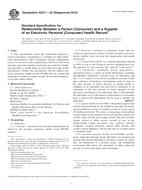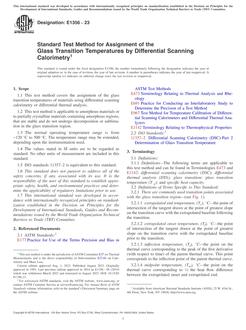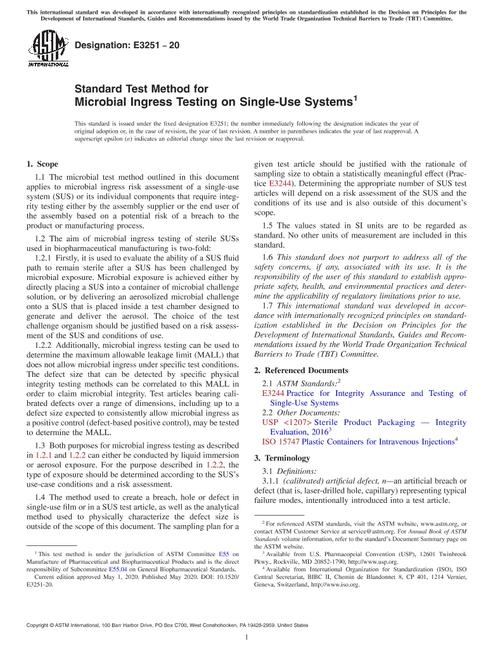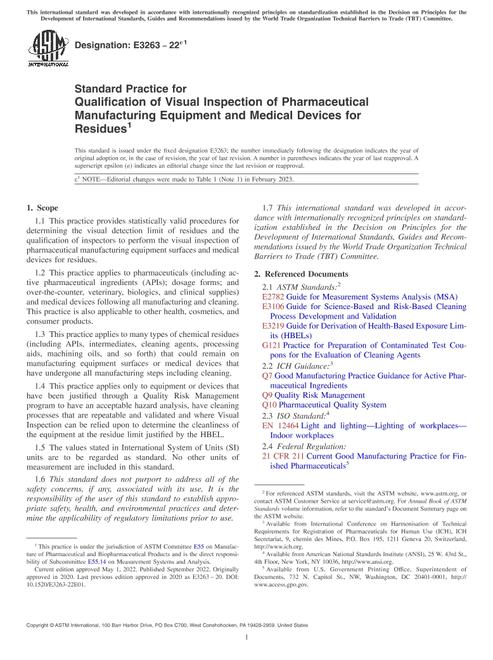-
-
Available Formats
- Availability
- Priced From ( in USD )
-
Available Formats
-
- Immediate download
- $63.00
- Add to Cart
-
- Printed Edition
- Ships in 1-2 business days
- $63.00
- Add to Cart
Customers Who Bought This Also Bought
-

ASTM E2211-02(2010)
Priced From $50.00 -

ASTM E1356-23
Priced From $50.00 -

ASTM E3251-20
Priced From $68.00 -

ASTM E3263-22e1
Priced From $82.00
About This Item
Full Description
1.1''The test methods described in this standard are applicable for single-use manufacturing equipment, further called Single-use Systems (SUSs), used for (bio)pharmaceutical products.
1.2''The test methods described in this standard are not intended to be used on single-use technology for primary containers, combination products (products composed of any combination of a drug, device, or biological product), or devices. Appropriate procedures related to these products are discussed in documents covering the integrity assurance for primary containers (1)2 or medical products (2-4).
1.3''The test methods and their validation are described to only cover testing of empty and dry SUSs. Residual liquid in the SUS can impact the test reliability and reproducibility.
1.4''The test methods are intended to be used to confirm the barrier properties of the test article, further called integrity testing, or test the SUS for leaks of certain sizes, further called leak testing.
Note 1:''To verify that an integrity test can confirm the intended barrier properties of the SUS, its detection limit must be equal or better than the respective maximum allowable leakage limit.
1.5''The physical test methods covered by this standard are:
1.5.1''Pressure-based test methods.
1.5.2''Tracer gas-based test methods.
1.6''The physical test methods described are in general non-destructive and allow further use of the SUS.
Note 2:''Some variations can be used in a destructive way, for example, to perform root cause analysis of the leak.
1.7''The standard describes the test apparatuses, operation procedures, environment requirements, and discusses specific challenges with testing SUSs, as well as how to perform robust validation of the test method.
1.8''This standard does not include methods to determine the maximum allowable leakage limit for maintaining the barrier properties of the SUS. For that, refer to Practice E3244 and Test Method E3251.
1.9''This standard does not describe how to select the appropriate test method. For that, refer to Practice E3244.
1.10''Furthermore, it does not discuss whether an integrity test should be conducted, at what frequency and where in the life cycle of a SUS. For that refer to Practice E3244.
1.11''Filter membrane integrity testing that additionally tests the integrity of the SUS is excluded from the scope. Certain components of the SUS may require additional testing.
1.12''This standard does not purport to address all of the safety concerns, if any, associated with its use. It is the responsibility of the user of this standard to establish appropriate safety, health, and environmental practices and determine the applicability of regulatory limitations prior to use.
1.13''This international standard was developed in accordance with internationally recognized principles on standardization established in the Decision on Principles for the Development of International Standards, Guides and Recommendations issued by the World Trade Organization Technical Barriers to Trade (TBT) Committee.





